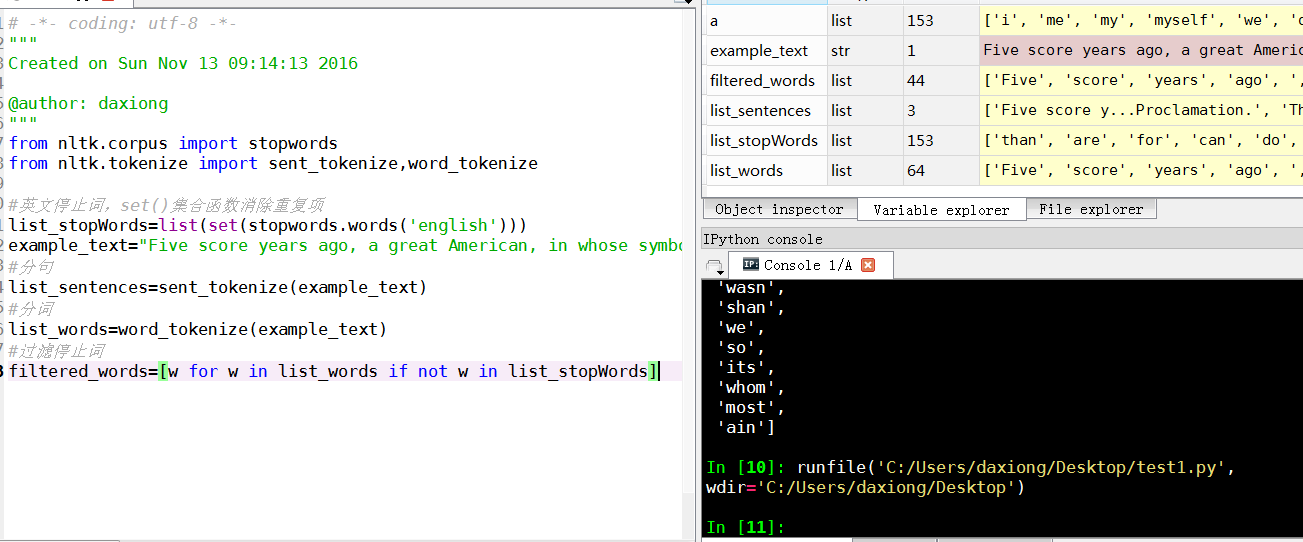自然语言13_Stop words with NLTK
python机器学习-乳腺癌细胞挖掘(博主亲自录制视频)https://study.163.com/course/introduction.htm?courseId=1005269003&utm_campaign=commission&utm_source=cp-400000000398149&utm_medium=share
# -*- coding: utf-8 -*-
"""
Created on Sun Nov 13 09:14:13 2016 @author: daxiong
"""
from nltk.corpus import stopwords
from nltk.tokenize import sent_tokenize,word_tokenize #英文停止词,set()集合函数消除重复项
list_stopWords=list(set(stopwords.words('english')))
example_text="Five score years ago, a great American, in whose symbolic shadow we stand today, signed the Emancipation Proclamation. This momentous decree came as a great beacon light of hope to millions of Negro slaves who had been seared in the flames of withering injustice. It came as a joyous daybreak to end the long night of bad captivity."
#分句
list_sentences=sent_tokenize(example_text)
#分词
list_words=word_tokenize(example_text)
#过滤停止词
filtered_words=[w for w in list_words if not w in list_stopWords]

Stop words with NLTK
The idea of Natural Language Processing is to do some form of
analysis, or processing, where the machine can understand, at least to
some level, what the text means, says, or implies.
This is an obviously massive challenge, but there are steps to
doing it that anyone can follow. The main idea, however, is that
computers simply do not, and will not, ever understand words directly.
Humans don't either *shocker*. In humans, memory is broken down into
electrical signals in the brain, in the form of neural groups that fire
in patterns. There is a lot about the brain that remains unknown, but,
the more we break down the human brain to the basic elements, we find
out basic the elements really are. Well, it turns out computers store
information in a very similar way! We need a way to get as close to that
as possible if we're going to mimic how humans read and understand
text. Generally, computers use numbers for everything, but we often see
directly in programming where we use binary signals (True or False,
which directly translate to 1 or 0, which originates directly from
either the presence of an electrical signal (True, 1), or not (False,
0)). To do this, we need a way to convert words to values, in numbers,
or signal patterns. The process of converting data to something a
computer can understand is referred to as "pre-processing." One of the
major forms of pre-processing is going to be filtering out useless data.
In natural language processing, useless words (data), are referred to
as stop words.
Immediately, we can recognize ourselves that some words carry more
meaning than other words. We can also see that some words are just
plain useless, and are filler words. We use them in the English
language, for example, to sort of "fluff" up the sentence so it is not
so strange sounding. An example of one of the most common, unofficial,
useless words is the phrase "umm." People stuff in "umm" frequently,
some more than others. This word means nothing, unless of course we're
searching for someone who is maybe lacking confidence, is confused, or
hasn't practiced much speaking. We all do it, you can hear me saying
"umm" or "uhh" in the videos plenty of ...uh ... times. For most
analysis, these words are useless.
We would not want these words taking up space in our database, or
taking up valuable processing time. As such, we call these words "stop
words" because they are useless, and we wish to do nothing with them.
Another version of the term "stop words" can be more literal: Words we
stop on.
For example, you may wish to completely cease analysis if you
detect words that are commonly used sarcastically, and stop immediately.
Sarcastic words, or phrases are going to vary by lexicon and corpus.
For now, we'll be considering stop words as words that just contain no
meaning, and we want to remove them.
You can do this easily, by storing a list of words that you
consider to be stop words. NLTK starts you off with a bunch of words
that they consider to be stop words, you can access it via the NLTK
corpus with:
from nltk.corpus import stopwords
Here is the list:
{'ourselves', 'hers', 'between', 'yourself', 'but', 'again', 'there',
'about', 'once', 'during', 'out', 'very', 'having', 'with', 'they',
'own', 'an', 'be', 'some', 'for', 'do', 'its', 'yours', 'such', 'into',
'of', 'most', 'itself', 'other', 'off', 'is', 's', 'am', 'or', 'who',
'as', 'from', 'him', 'each', 'the', 'themselves', 'until', 'below',
'are', 'we', 'these', 'your', 'his', 'through', 'don', 'nor', 'me',
'were', 'her', 'more', 'himself', 'this', 'down', 'should', 'our',
'their', 'while', 'above', 'both', 'up', 'to', 'ours', 'had', 'she',
'all', 'no', 'when', 'at', 'any', 'before', 'them', 'same', 'and',
'been', 'have', 'in', 'will', 'on', 'does', 'yourselves', 'then',
'that', 'because', 'what', 'over', 'why', 'so', 'can', 'did', 'not',
'now', 'under', 'he', 'you', 'herself', 'has', 'just', 'where', 'too',
'only', 'myself', 'which', 'those', 'i', 'after', 'few', 'whom', 't',
'being', 'if', 'theirs', 'my', 'against', 'a', 'by', 'doing', 'it',
'how', 'further', 'was', 'here', 'than'}
Here is how you might incorporate using the stop_words set to remove the stop words from your text:
from nltk.corpus import stopwords
from nltk.tokenize import word_tokenize example_sent = "This is a sample sentence, showing off the stop words filtration." stop_words = set(stopwords.words('english')) word_tokens = word_tokenize(example_sent) filtered_sentence = [w for w in word_tokens if not w in stop_words] filtered_sentence = [] for w in word_tokens:
if w not in stop_words:
filtered_sentence.append(w) print(word_tokens)
print(filtered_sentence)
Our output here:['This', 'is', 'a', 'sample', 'sentence', ',', 'showing', 'off', 'the', 'stop', 'words', 'filtration', '.']
['This', 'sample', 'sentence', ',', 'showing', 'stop', 'words', 'filtration', '.']
Our database thanks us. Another form of data pre-processing is 'stemming,' which is what we're going to be talking about next.
自然语言13_Stop words with NLTK的更多相关文章
- 自然语言处理(1)之NLTK与PYTHON
自然语言处理(1)之NLTK与PYTHON 题记: 由于现在的项目是搜索引擎,所以不由的对自然语言处理产生了好奇,再加上一直以来都想学Python,只是没有机会与时间.碰巧这几天在亚马逊上找书时发现了 ...
- 自然语言23_Text Classification with NLTK
QQ:231469242 欢迎喜欢nltk朋友交流 https://www.pythonprogramming.net/text-classification-nltk-tutorial/?compl ...
- 自然语言20_The corpora with NLTK
QQ:231469242 欢迎喜欢nltk朋友交流 https://www.pythonprogramming.net/nltk-corpus-corpora-tutorial/?completed= ...
- 自然语言19.1_Lemmatizing with NLTK(单词变体还原)
QQ:231469242 欢迎喜欢nltk朋友交流 https://www.pythonprogramming.net/lemmatizing-nltk-tutorial/?completed=/na ...
- 自然语言14_Stemming words with NLTK
https://www.pythonprogramming.net/stemming-nltk-tutorial/?completed=/stop-words-nltk-tutorial/ # -*- ...
- 自然语言处理2.1——NLTK文本语料库
1.获取文本语料库 NLTK库中包含了大量的语料库,下面一一介绍几个: (1)古腾堡语料库:NLTK包含古腾堡项目电子文本档案的一小部分文本.该项目目前大约有36000本免费的电子图书. >&g ...
- python自然语言处理函数库nltk从入门到精通
1. 关于Python安装的补充 若在ubuntu系统中同时安装了Python2和python3,则输入python或python2命令打开python2.x版本的控制台:输入python3命令打开p ...
- Python自然语言处理实践: 在NLTK中使用斯坦福中文分词器
http://www.52nlp.cn/python%E8%87%AA%E7%84%B6%E8%AF%AD%E8%A8%80%E5%A4%84%E7%90%86%E5%AE%9E%E8%B7%B5-% ...
- 推荐《用Python进行自然语言处理》中文翻译-NLTK配套书
NLTK配套书<用Python进行自然语言处理>(Natural Language Processing with Python)已经出版好几年了,但是国内一直没有翻译的中文版,虽然读英文 ...
随机推荐
- yii2权限控制rbac之菜单menu最详细教程
前面我们在博文 yii2搭建完美后台并实现rbac权限控制实例教程中完美实现了yii2的后台搭建和rbac权限控制,如果你还没有实现,请先看上文再回来参考本文,因为本文是在上文的基础上进行完善和补充. ...
- 软件工程-pair work
如果用两个字来形容这次的任务,那一定是"卧槽" 结对编程人员 177 吴渊渊 193 薛亚杰 照至少一张照片, 展现两人在一起合作编程的情况. 说明结对编程的优点和缺点. 优点: ...
- 十天冲刺---Day6
站立式会议 站立式会议内容总结: 燃尽图 照片 一个队友回家有事,一个队友参加校运会比赛,只剩下两个人. 失去了UI是噩梦
- 安装myeclipse10后破解时发现没有common文件夹
今天重新安装了myeclipse10软件,然后在破解的时候发现安装目录下没有common,这是因为以前安装过myeclipse,卸载时没有完全清除,再次安装时,myeclipse会自动找到以前安装的c ...
- restFull常用注解
@GET.@POST.@PUT.@DELETE.@HEAD您可以使用它们来绑定根资源或子资源内的 Java 方法与 HTTP 请求方法.HTTP GET 请求被映射到由 @GET 注释的方法,以此类推 ...
- 在无修改权限的情况下修改文件hosts中的内容
今天遇到了一个问题,本来希望修改hosts中的内容,但保存时被告知无权限,网上搜索有很多方法都无效,最后搜到一个简单的方法:将hosts文件复制到桌面上,修改,然后覆盖原来位置的hosts文件即可!
- mysql中IFIND_IN_SET和like的区别
在数据库中新建一张测试表t_user,包含三个字段'id','name','grilfriend',字段很容易看出,这是记录一个人的女朋友的表,注意这里的‘firlfriend’字段可以是多个人名,之 ...
- SQL复习
1.select SELECT LastName,FirstName FROM Persons SELECT * FROM Persons 2.distinct SELECT DISTINCT Com ...
- js自定义正则表达式
<script>var r, re; // 声明变量. var s = "The rain in Spain falls mainly in the plain."; ...
- jquery失去焦点与获取焦点事件blur() focus()
以前我们在js中写input各种事件时都会直接在input中写,昨天开始我开始全面使用jquery了,现在来谈一下我对jquery blur() focus()事件的学习笔记. 对于元素的焦点事件,我 ...


